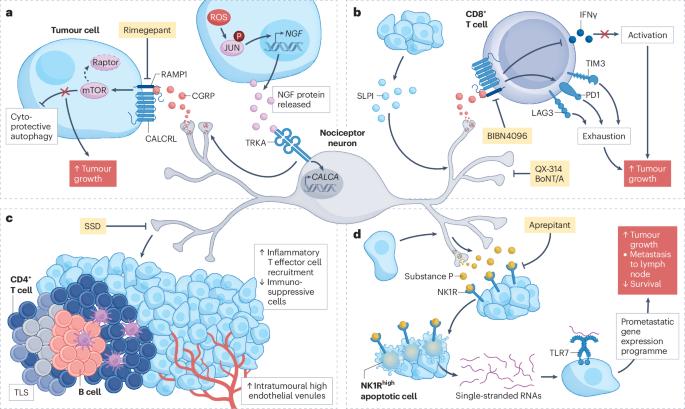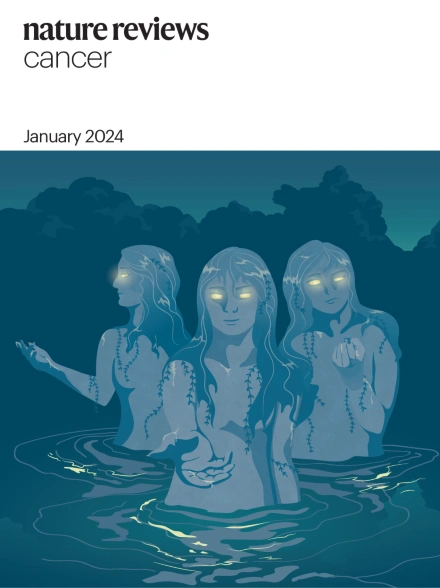Neuro-immune cross-talk in cancer
IF 66.8
1区 医学
Q1 ONCOLOGY
引用次数: 0
Abstract
The nervous and immune systems have co-evolved to detect and respond to internal and external threats, working together to restore homeostasis after tissue injury or infection. Sharing several receptors and ligands, they engage in direct cross-talk that substantially influences disease development. The emerging field of cancer neuro-immunity focuses on the intricate interactions between the nervous system, immune responses and tumour growth. Additional findings have revealed that nerve fibres infiltrating peripheral tumours can release neuromodulatory factors that shape both immune cell behaviour and tumour progression. Conversely, tumour-infiltrating immune cells can modify the activity of local neurons, including pain-transmitting nociceptive sensory neurons. Beyond sensory fibres, sympathetic signalling can foster immunosuppression by recruiting myeloid-derived suppressor cells and promoting T cell exhaustion. This Review summarizes current evidence on how neuronal signalling regulates peripheral antitumour immune responses within the tumour microenvironment. We describe the complex, reciprocal interactions among neurons, immune cells and malignant cells, highlighting the key parts played by the peripheral nervous system in modulating immunity against cancer. By understanding this neuro-immune axis, novel therapeutic approaches may be uncovered to strengthen antitumour immunity and enhance responses to existing cancer treatments. The nervous and immune systems have co-evolved to respond to threats, including cancer. In this Review, Amit et al. outline the reciprocal interactions among neurons, immune cells and tumour cells that regulate peripheral antitumour immune responses and discuss how these mechanisms could be leveraged to enhance immunotherapy.


癌症中的神经免疫串扰
神经系统和免疫系统共同进化,以检测和应对内部和外部威胁,共同努力在组织损伤或感染后恢复体内平衡。它们共享几个受体和配体,参与直接的串扰,实质性地影响疾病的发展。肿瘤神经免疫这一新兴领域关注神经系统、免疫反应和肿瘤生长之间复杂的相互作用。其他研究结果表明,浸润周围肿瘤的神经纤维可以释放神经调节因子,影响免疫细胞的行为和肿瘤的进展。相反,肿瘤浸润的免疫细胞可以改变局部神经元的活动,包括传递疼痛的伤害感觉神经元。除了感觉纤维外,交感信号还可以通过募集髓源性抑制细胞和促进T细胞衰竭来促进免疫抑制。这篇综述总结了目前关于肿瘤微环境中神经元信号如何调节外周抗肿瘤免疫反应的证据。我们描述了神经元、免疫细胞和恶性细胞之间复杂的相互作用,突出了周围神经系统在调节抗癌免疫中发挥的关键作用。通过了解这一神经免疫轴,新的治疗方法可能会被发现,以增强抗肿瘤免疫和增强对现有癌症治疗的反应。
本文章由计算机程序翻译,如有差异,请以英文原文为准。
求助全文
约1分钟内获得全文
求助全文
来源期刊

Nature Reviews Cancer
医学-肿瘤学
CiteScore
111.90
自引率
0.40%
发文量
97
审稿时长
6-12 weeks
期刊介绍:
Nature Reviews Cancer, a part of the Nature Reviews portfolio of journals, aims to be the premier source of reviews and commentaries for the scientific communities it serves. The correct abbreviation for abstracting and indexing purposes is Nat. Rev. Cancer. The international standard serial numbers (ISSN) for Nature Reviews Cancer are 1474-175X (print) and 1474-1768 (online). Unlike other journals, Nature Reviews Cancer does not have an external editorial board. Instead, all editorial decisions are made by a team of full-time professional editors who are PhD-level scientists. The journal publishes Research Highlights, Comments, Reviews, and Perspectives relevant to cancer researchers, ensuring that the articles reach the widest possible audience due to their broad scope.
 求助内容:
求助内容: 应助结果提醒方式:
应助结果提醒方式:


